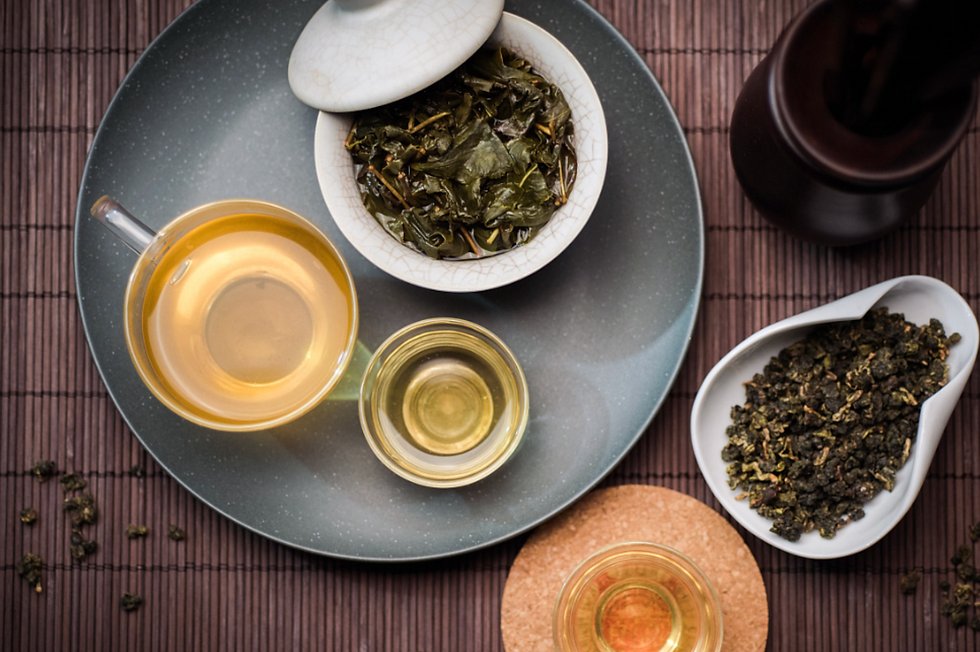
Brief history of tea in China
One story connects it with Emperor Shen Nung, who drank only boiled water when traveling around the country. Once a branch of a burning brush was blown into the already bubbling water. Much to his surprise, the emperor noted a most pleasant taste and a beautiful aroma in the new beverage. His discovery was tea!

Each of these teas offers a glimpse into the diverse landscapes, cultures, and traditions of China, inviting tea lovers to embark on a sensory journey unlike any other.

GREEN TEA (unwilted and unoxidised)
-
Production process: Fixation, shaping, and drying.
-
Characteristics: Distinct green coloured tea base and leaves when brewed. Light and delicate flavour, with fresh lingering aftertaste.
-
Examples: Longjing/ Biluochun/Huangshan Maofeng
Green tea is the most common type of tea drink by the Chinese throughout the history. It is cultivated mainly in Zhejiang, Jiangsu, Anhui, Henan, Hunan, Hubei, Guangxi, and Guangdong. Fresh green tea leaves are steamed, which preserves the polyphenols, which have strong antioxidant benefits. Green tea contains least amount of caffeine among all six types of tea.

WHITE TEA (wilted and 5-10% oxidised)
-
Production process: Withering, shaping and drying.
-
Characteristics: White furry surface of dried tea leaves. Sweet, mild, and fruity taste.
-
Examples: Baihao Yinzhen/ ‘White Peony’/ Gongmei
White tea is the least processed form of tea and it is mainly cultivated in Zhenghe and Fuding regions in Fujian Province. The leaves of white tea are harvested when they still are covered in silvery white hairs. This type of tea provide a more delicate flavour and contains second least amount of caffeine.

YELLOW TEA (unwilted and 10-20% unoxidised)
-
Production process: Fixation, shaping, heaping to yellow, and drying.
-
Characteristics: Fragrant flavour with fresh aftertaste.
-
Examples: Junshan Yinzhen/ Huoshan Huangya/ Mengding Huangya
With similar production process as green tea, yellow tea has a more distinctive fragrant initial taste. It is cultivated mainly in Hunan, Hubei, Sichuan, Guangdong, Zhejiang and Anhui.

OOLONG TEA (Wilted, bruised and 10-70% oxidised)
-
Production process: Withering, oxidation, fixation, shaping, and drying.
-
Characteristics: Red colour edged green leaves when brewed. Delicate bitter flavour with long-lasting sweet aftertaste.
-
Examples: Tieguanyin/ Wuyi Dahongpao
Oolong tea is made from partially oxidized tea leaves and may contain similar levels of caffeine as white and green tea, depending on the length of the oxidation process. It is primarily grown in Fujian, Guangdong, and Taiwan.

BLACK TEA (Wilted, sometimes crushed, and 70-90 % oxidised)
-
Production process: Withering, shaping, oxidation, and drying.
-
Characteristics: Red coloured tea base and leaves when brewed. Strong, robust initial flavour with fruity and sweet aftertaste.
-
Examples: Keemun Tea/ Wuyi Jinjunmei/ Lapsang souchong
Black tea is the most processed of the tea leaves, containing more caffeine than any other teas made from Camellia sinensis plant. It is mainly grown in southeast coastal region of China alongside Yunnan and Sichuan provinces.

FLOWER TEA AND HERBAL TEA represent another dimension of China's rich tea culture, offering a diverse range of flavors and health benefits. Let's explore these along with the unique tea customs of some of China's ethnic minority groups:
-
Chrysanthemum Tea: Made from dried chrysanthemum flowers, this delicate herbal infusion is celebrated for its floral aroma and refreshing taste. Chrysanthemum tea is believed to have cooling properties and is often enjoyed during hot summer months to help alleviate heat-related ailments.
-
Wolfberry Tea: Also known as goji berry tea, wolfberry tea is made from the dried fruits of the goji plant. Renowned for their antioxidant properties, wolfberries are believed to promote longevity and vitality. Wolfberry tea has a sweet, slightly tart flavor and is often enjoyed for its health benefits.
-
Jasmine Tea: Jasmine tea is made by scenting green tea leaves with fresh jasmine flowers, resulting in a fragrant and aromatic brew. Originating from the Fujian province, jasmine tea is prized for its floral notes and smooth, mellow taste. It's a popular choice for relaxation and meditation.
-
Osmanthus Tea: Osmanthus tea is crafted from the fragrant blossoms of the osmanthus tree, which are dried and infused with green or black tea leaves. With its sweet, apricot-like aroma and delicate floral flavor, osmanthus tea is a favorite among tea enthusiasts seeking a sensory experience.
As you jump to the more remote regions in China, you’ll meet different ethnic minorities
with the same habit of consuming tea yet in their own unique ways.
So the British take their tea with milk,
Frisians in northern Germany enjoy it with white rock candy and a topping of cream,
Moroccans flavor it with mint, while
Tibetans add salt and yak butter to it.
Yet, many tea lovers adhere to old Lu Yu’s suggestion,
prepare tea with fresh boiling mountain water,
wherever that is still available.
After reading so much about tea, do you feel thirsty?
Why not have a nice cup of tea right now?